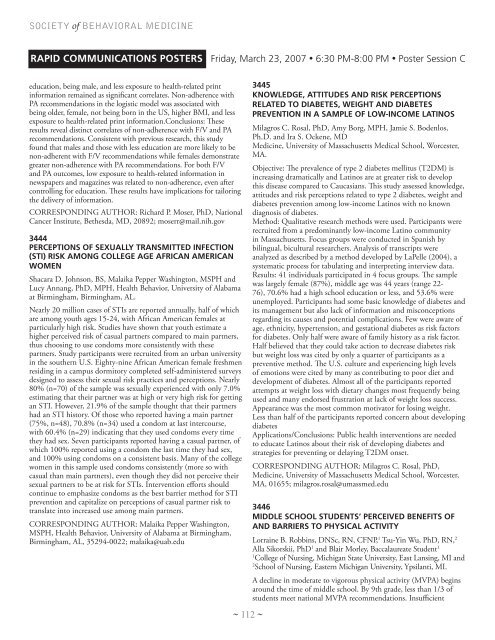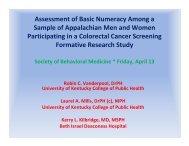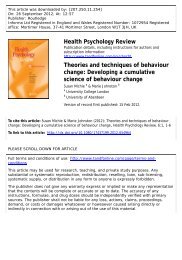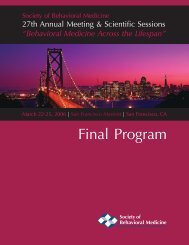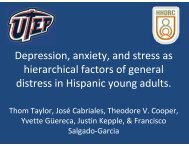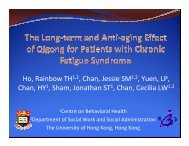2007 Final Program - Society of Behavioral Medicine
2007 Final Program - Society of Behavioral Medicine
2007 Final Program - Society of Behavioral Medicine
You also want an ePaper? Increase the reach of your titles
YUMPU automatically turns print PDFs into web optimized ePapers that Google loves.
SOCIETY <strong>of</strong> BEHAVIORAL MEDICINE<br />
Rapid Communications Posters Friday, March 23, <strong>2007</strong> • 6:30 PM-8:00 PM • Poster Session C<br />
education, being male, and less exposure to health-related print<br />
information remained as significant correlates. Non-adherence with<br />
PA recommendations in the logistic model was associated with<br />
being older, female, not being born in the US, higher BMI, and less<br />
exposure to health-related print information.Conclusions: These<br />
results reveal distinct correlates <strong>of</strong> non-adherence with F/V and PA<br />
recommendations. Consistent with previous research, this study<br />
found that males and those with less education are more likely to be<br />
non-adherent with F/V recommendations while females demonstrate<br />
greater non-adherence with PA recommendations. For both F/V<br />
and PA outcomes, low exposure to health-related information in<br />
newspapers and magazines was related to non-adherence, even after<br />
controlling for education. These results have implications for tailoring<br />
the delivery <strong>of</strong> information.<br />
CORRESPONDING AUTHOR: Richard P. Moser, PhD, National<br />
Cancer Institute, Bethesda, MD, 20892; moserr@mail.nih.gov<br />
3444<br />
PERCEPTIONS OF SEXUALLY TRANSMITTED INFECTION<br />
(STI) RISK AMONG COLLEGE AGE AFRICAN AMERICAN<br />
WOMEN<br />
Shacara D. Johnson, BS, Malaika Pepper Washington, MSPH and<br />
Lucy Annang, PhD, MPH, Health Behavior, University <strong>of</strong> Alabama<br />
at Birmingham, Birmingham, AL.<br />
Nearly 20 million cases <strong>of</strong> STIs are reported annually, half <strong>of</strong> which<br />
are among youth ages 15-24, with African American females at<br />
particularly high risk. Studies have shown that youth estimate a<br />
higher perceived risk <strong>of</strong> casual partners compared to main partners,<br />
thus choosing to use condoms more consistently with these<br />
partners. Study participants were recruited from an urban university<br />
in the southern U.S. Eighty-nine African American female freshmen<br />
residing in a campus dormitory completed self-administered surveys<br />
designed to assess their sexual risk practices and perceptions. Nearly<br />
80% (n=70) <strong>of</strong> the sample was sexually experienced with only 7.0%<br />
estimating that their partner was at high or very high risk for getting<br />
an STI. However, 21.9% <strong>of</strong> the sample thought that their partners<br />
had an STI history. Of those who reported having a main partner<br />
(75%, n=48), 70.8% (n=34) used a condom at last intercourse,<br />
with 60.4% (n=29) indicating that they used condoms every time<br />
they had sex. Seven participants reported having a casual partner, <strong>of</strong><br />
which 100% reported using a condom the last time they had sex,<br />
and 100% using condoms on a consistent basis. Many <strong>of</strong> the college<br />
women in this sample used condoms consistently (more so with<br />
casual than main partners), even though they did not perceive their<br />
sexual partners to be at risk for STIs. Intervention efforts should<br />
continue to emphasize condoms as the best barrier method for STI<br />
prevention and capitalize on perceptions <strong>of</strong> casual partner risk to<br />
translate into increased use among main partners.<br />
CORRESPONDING AUTHOR: Malaika Pepper Washington,<br />
MSPH, Health Behavior, University <strong>of</strong> Alabama at Birmingham,<br />
Birmingham, AL, 35294-0022; malaika@uab.edu<br />
3445<br />
KNOWLEDGE, ATTITUDES AND RISK PERCEPTIONS<br />
RELATED TO DIABETES, WEIGHT AND DIABETES<br />
PREVENTION IN A SAMPLE OF LOW-INCOME LATINOS<br />
Milagros C. Rosal, PhD, Amy Borg, MPH, Jamie S. Bodenlos,<br />
Ph.D. and Ira S. Ockene, MD<br />
<strong>Medicine</strong>, University <strong>of</strong> Massachusetts Medical School, Worcester,<br />
MA.<br />
Objective: The prevalence <strong>of</strong> type 2 diabetes mellitus (T2DM) is<br />
increasing dramatically and Latinos are at greater risk to develop<br />
this disease compared to Caucasians. This study assessed knowledge,<br />
attitudes and risk perceptions related to type 2 diabetes, weight and<br />
diabetes prevention among low-income Latinos with no known<br />
diagnosis <strong>of</strong> diabetes.<br />
Method: Qualitative research methods were used. Participants were<br />
recruited from a predominantly low-income Latino community<br />
in Massachusetts. Focus groups were conducted in Spanish by<br />
bilingual, bicultural researchers. Analysis <strong>of</strong> transcripts were<br />
analyzed as described by a method developed by LaPelle (2004), a<br />
systematic process for tabulating and interpreting interview data.<br />
Results: 41 individuals participated in 4 focus groups. The sample<br />
was largely female (87%), middle age was 44 years (range 22-<br />
76), 70.6% had a high school education or less, and 53.6% were<br />
unemployed. Participants had some basic knowledge <strong>of</strong> diabetes and<br />
its management but also lack <strong>of</strong> information and misconceptions<br />
regarding its causes and potential complications. Few were aware <strong>of</strong><br />
age, ethnicity, hypertension, and gestational diabetes as risk factors<br />
for diabetes. Only half were aware <strong>of</strong> family history as a risk factor.<br />
Half believed that they could take action to decrease diabetes risk<br />
but weight loss was cited by only a quarter <strong>of</strong> participants as a<br />
preventive method. The U.S. culture and experiencing high levels<br />
<strong>of</strong> emotions were cited by many as contributing to poor diet and<br />
development <strong>of</strong> diabetes. Almost all <strong>of</strong> the participants reported<br />
attempts at weight loss with dietary changes most frequently being<br />
used and many endorsed frustration at lack <strong>of</strong> weight loss success.<br />
Appearance was the most common motivator for losing weight.<br />
Less than half <strong>of</strong> the participants reported concern about developing<br />
diabetes<br />
Applications/Conclusions: Public health interventions are needed<br />
to educate Latinos about their risk <strong>of</strong> developing diabetes and<br />
strategies for preventing or delaying T2DM onset.<br />
CORRESPONDING AUTHOR: Milagros C. Rosal, PhD,<br />
<strong>Medicine</strong>, University <strong>of</strong> Massachusetts Medical School, Worcester,<br />
MA, 01655; milagros.rosal@umassmed.edu<br />
3446<br />
MIDDLE SCHOOL STUDENTS’ PERCEIVED BENEFITS OF<br />
AND BARRIERS TO PHYSICAL ACTIVITY<br />
Lorraine B. Robbins, DNSc, RN, CFNP, 1 Tsu-Yin Wu, PhD, RN, 2<br />
Alla Sikorskii, PhD 1 and Blair Morley, Baccalaureate Student 1<br />
1<br />
College <strong>of</strong> Nursing, Michigan State University, East Lansing, MI and<br />
2<br />
School <strong>of</strong> Nursing, Eastern Michigan University, Ypsilanti, MI.<br />
~ 112 ~<br />
A decline in moderate to vigorous physical activity (MVPA) begins<br />
around the time <strong>of</strong> middle school. By 9th grade, less than 1/3 <strong>of</strong><br />
students meet national MVPA recommendations. Insufficient


